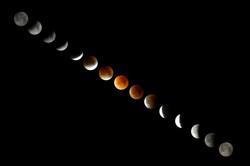Glossarbegriffe: Eklipse
Description: Eine Eklipse tritt auf, wenn ein astronomisches Objekt vorübergehend verdunkelt wird indem es entweder in den Schatten eines anderen Himmelskörper eintritt oder wenn sich ein anderer Körper zwischen den Betrachter und das Objekt schiebt. Ein Beispiel für eine Eklipse ist eine Mondfinsternis, wenn die Erde zwischen Sonne und Mond steht und der Mond in den Erdschatten eintritt. Ein weiteres Beispiel ist eine Sonnenfinsternis: Dabei bewegt sich der Mond zwischen Erde und Sonne und blockiert so das Licht der Sonne teilweise oder ganz. Von einer Bedeckung (oder Okkultation) spricht man, wenn der verdeckende Körper scheinbar größer als der verdeckte Körper ist und ihn deshalb vollständig verdeckt. Im umgekehrten Fall heißt dieses Phänomen Durchgang (Transit): Der vorbeiziehende Himmelskörper verdeckt nur einen kleinen Teil des anderen Objekts.
Zugehörige Glossarbegriffe:
See this term in other languages
Term and definition status: The original definition of this term in English have been approved by a research astronomer and a teacher The translation of this term and its definition is still awaiting approval
The OAE Multilingual Glossary is a project of the IAU Office of Astronomy for Education (OAE) in collaboration with the IAU Office of Astronomy Outreach (OAO). The terms and definitions were chosen, written and reviewed by a collective effort from the OAE, the OAE Centers and Nodes, the OAE National Astronomy Education Coordinators (NAECs) and other volunteers. You can find a full list of credits here. All glossary terms and their definitions are released under a Creative Commons CC BY-4.0 license and should be credited to "IAU OAE".
If you notice a factual or translation error in this glossary term or definition then please get in touch.
Zugehörige Medien
The Eclipse Between Us, by Muhammad Rayhan, Indonesia
Bildnachweis: Muhammad Rayhan/IAU OAE
License: CC-BY-4.0 Creative Commons Namensnennung 4.0 International (CC BY 4.0) icons
Red Moon, by Daniel Henrion, France
Bildnachweis: Daniel Henrion/IAU OAE
License: CC-BY-4.0 Creative Commons Namensnennung 4.0 International (CC BY 4.0) icons










